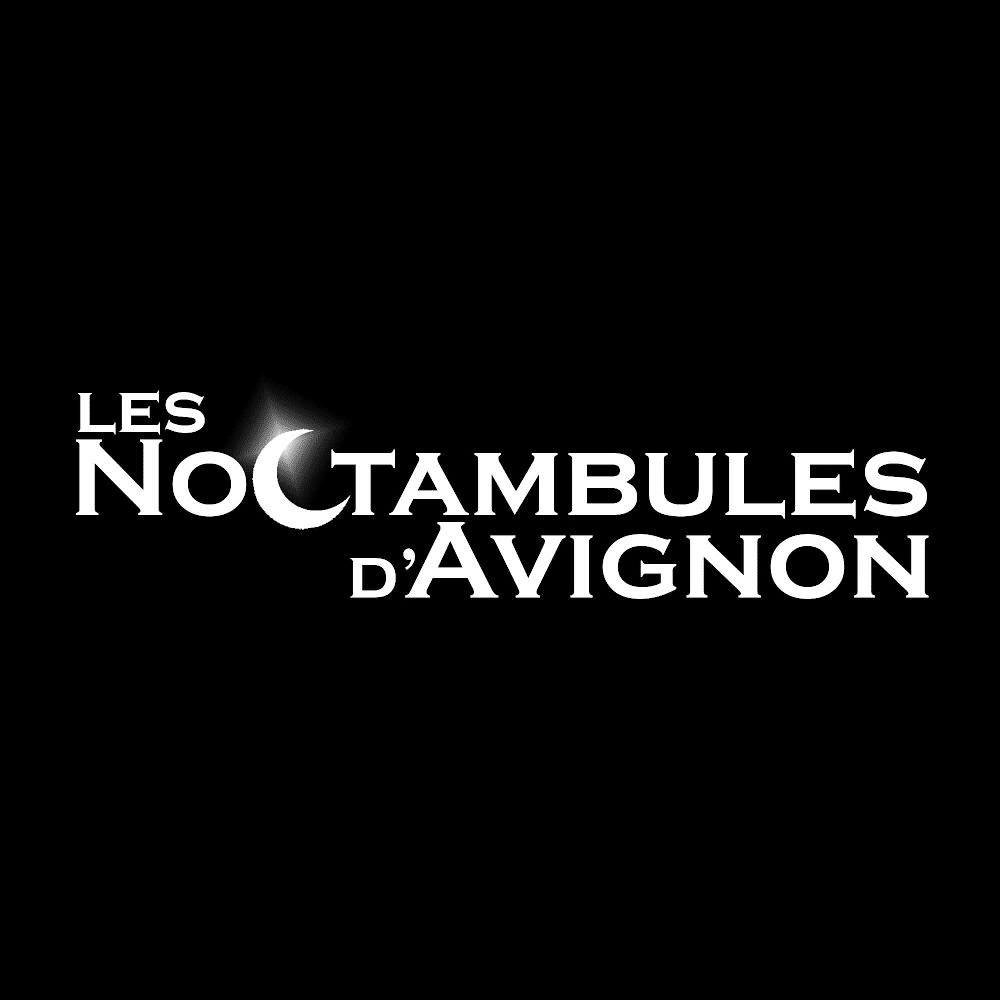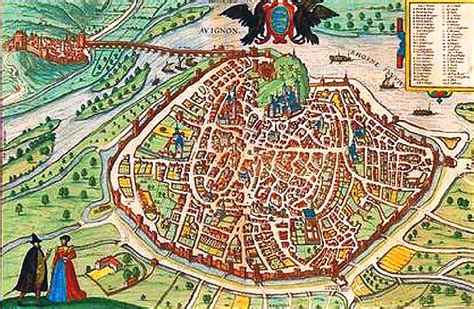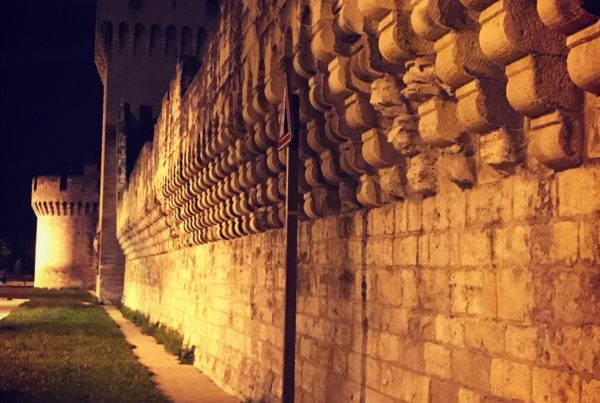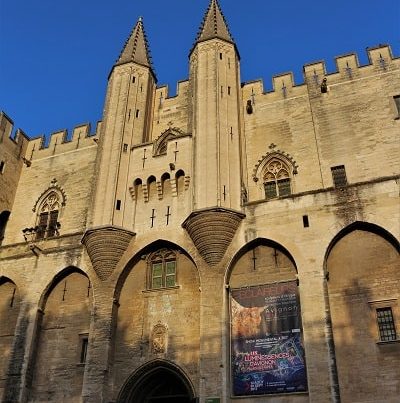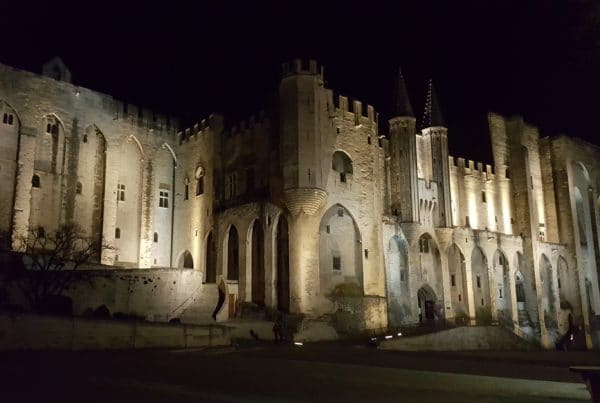Some towns have a far greater historical influence than they do today. Avignon is a perfect example. Once the capital of Christianity between the 13th and 15th centuries, this emblematic city in the south of France was once again a quiet provincial town before the Avignon Festival breathed new life into it.
Avignon, from prehistory to the arrival of the Popes
Archaeological digs carried out in the 1960s revealed traces of human occupation as far back as the Copper Age around the famous Rocher des Doms, a must-see site when visiting Avignon. A sculpture typical of funerary stelae from this period was discovered there, bearing witness to the first human settlements. It has been called the first Avignonnais and is on display at the Musée Calvet.
The Phocaeans from Massalia (Marseille) founded Avenio, the ancient name of Avignon, in 539 BC. The Greek geographer Artemidorus of Ephesus mentions Avignon as a city of Massalia near the Rhône, and the first urban structures were organised around the Rocher des Doms. Having become a Roman colony in 121 AD, Avignon expanded and saw its administrative centre, the forum, established on the site of today’s Hôtel de Ville. Roman remains can still be seen today behind the imposing Popes Palace.
With the development of Christianity, the first Christian community settled outside the city in the 3rd century, on the site of what is now Saint-Ruf Abbey. The gradual Christianisation of Avignon is attested to by the presence of Nextarius, the city’s first bishop, who took part in the Council of Riez in 439.
The arrival of the Popes and the city’s golden age
In the 13th century, following the division of the Carolingian Empire, the town became the property of the Counts of Provence. In 1290, the town was ceded to Charles II of Anjou.
History changed in 1305 with the election of Pope Bertrand de Got, under the name of Clément V, who chose Avignon as his temporary residence in 1309. This choice was dictated by the holding of an important council in Vienne, intended to judge the Templar order. He established the papal residence in Avignon, then under the authority of the Count of Provence.
But it was under John XXII, former archbishop of Avignon, that the city officially became the capital of the papacy. He refurbished the bishop’s palace. Benedict XII then ordered the construction of the Old Palace, while Clement VI extended the complex with the New Palace. They were known as the Pope-Builders. The latter also enriched the city with prestigious buildings and welcomed many artists and intellectuals, making Avignon a radiant cultural centre.
Innocent VI built the city walls of Avignon, which can still be seen today and are among the best preserved in Europe.
The Popes Palace is now a UNESCO World Heritage Site. It is one of the most visited monuments in France and a must-see if you want to discover Avignon.
From the Great Schism to the Revolution: between crisis and prosperity
The Great Schism and the two antipopes of Avignon
After the definitive departure of the papacy for Rome in 1376, Avignon never regained its status as the capital of Christianity. However, in spite of itself, the city was at the centre of one of the greatest religious conflicts of the Middle Ages: the Great Western Schism (1378-1417).
In 1378, following the death of Pope Gregory XI, a new pope, Urban VI, was elected in Rome. However, some of the cardinals, mainly French, rejected this election on the pretext that it had been made under pressure from the people of Rome. In response, these cardinals elected a second pope in Avignon: Clement VII (Robert of Geneva), who took up residence in the Pope Palace in 1379. Thus began the schism that divided Christendom.
For almost 40 years, two rival popes disputed the legitimacy of the throne of St Peter’s:
- Clement VII (1378-1394): recognised by France, Castile, Aragon, Scotland and Naples.
- Benedict XIII (1394-1417): successor to Clement VII, he refused to abdicate even after the schism had been resolved.
Faced with this division, which weakened the Church, a third pope, Alexander V, was elected in 1409 at the Council of Pisa. But his election only added to the confusion.
Finally, the Council of Constance (1414-1418) put an end to the crisis. After the deposition of the three rival popes, Martin V was elected in 1417, putting an end to the schism. However, Benedict XIII, who had taken refuge in his palace, refused to recognise this decision and remained cloistered for five years, until France stopped supporting him in 1423. His successor, Clement VIII, abdicated in 1429, marking the definitive end of papal power in Avignon.
Between the end of the Great Schism and the 20th century: From papal city to provincial town
After the end of the Great Western Schism in 1417, Avignon remained under the authority of the Holy See, remaining a papal enclave on French territory. However, this period saw a gradual decline in its influence. Deprived of the prestige it had enjoyed as a papal residence, the city became a mere administrative centre governed by papal legates and vice-legates, representatives of the Pope. Despite this, it continued to be a thriving commercial crossroads thanks to its strategic position on the Rhône, facilitating trade between Provence, the Rhône Valley and Italy. Its economy was based mainly on trade, crafts and, above all, silk, which became a key industry from the 16th century onwards.
However, Avignon also suffered crises: in the 16th century, it was affected by the Wars of Religion, and in 1663, a major plague decimated part of its population. The 18th century marked a period of growing contestation of papal power by the people of Avignon, who demanded greater autonomy and rights similar to those enjoyed by subjects of the King of France.
The French Revolution put an end to papal domination of the city: in 1791, following a local referendum, Avignon became part of France, along with the Comtat Venaissin. The Napoleonic period and then the Restoration confirmed this integration, transforming Avignon into a simple prefecture of the Vaucluse. In the 19th and early 20th centuries, the city retained a regional role thanks to trade, the rise of the railway and the development of wine-growing in the surrounding area, but it lost its international prestige. It wasn’t until the creation of the Festival d’Avignon in 1947 that the city regained its cultural influence on a global scale.
The Creation of the Festival d’Avignon: A Cultural Renaissance Led by Jean Vilar and Yvonne Zervos
The Context: A City in Search of Renewal
At the beginning of the 20th century, Avignon was a provincial town marked by economic decline due to the disappearance of the silk industry and the loss of its strategic role. Although the Popes Palace and the Pont Saint-Bénézet were already attracting visitors, the city did not yet have the international cultural influence it enjoys today.
The inter-war years and the German occupation during the Second World War accentuated Avignon’s withdrawal from the national scene. It was against this backdrop that an initiative emerged that would change the city’s destiny forever: the creation of the Festival d’Avignon in 1947.
Yvonne Zervos : A Key Figure in the Birth of the Festival
While the Festival d’Avignon is often associated with director Jean Vilar, it also owes its existence to an influential woman in the French cultural milieu: Yvonne Zervos.
Yvonne Zervos (1905-1970) was a patron of the arts, art critic and gallery owner, married to the famous publisher and art historian Christian Zervos, founder of the magazine Cahiers d’Art. Passionate about art and modernity, she and her husband owned a house in Avignon, where they welcomed many artists and intellectuals.
In the 1940s, she discovered the work of Jean Vilar, a young director committed to popular theatre. She was won over by his vision: to make theatre accessible to as many people as possible, far from the Parisian elite. Yvonne Zervos, with her network and influence, was to play a decisive role in the birth of the festival.
Meeting Jean Vilar and the birth of the Festival
In 1947, Jean Vilar was still a little-known theatre director, but he and Yvonne Zervos shared a common ambition: to make theatre a lively and popular event, breaking away from traditional theatrical institutions.
It was against this backdrop that Yvonne Zervos suggested he organise a theatre festival in Avignon. Her idea was to use the exceptional setting of the Pope Palace, a monument steeped in history, as an open-air stage for plays on a scale never seen before.
Jean Vilar accepted the challenge and, in September 1947, presented three plays in the main courtyard of the Pope Palace:
- Shakespeare’s Richard II,
- The Tragedy of King Richard II, directed by himself,
- The story of Tobie and Sara, by Paul Claudel.
The success was immediate. The audience, made up of Avignon locals, Parisians and curious onlookers alike, was won over by this new way of performing theatre, outdoors in a majestic setting. The Festival d’Avignon was born.
The Festival d’Avignon: A Cultural Revolution
Thanks to Jean Vilar and the support of Yvonne Zervos, the Festival quickly gained momentum. From the very first editions, it stood out for several innovative aspects:
- Popular theatre: unlike bourgeois Parisian theatre, the Festival d’Avignon offered theatre that was accessible to all, rooted in the values of sharing and transmission.
- An unprecedented space for creation: The Palais des Papes becomes a mythical stage, where directors can experiment with spectacular stagings.
- A dialogue between theatre and the visual arts: Thanks to Yvonne Zervos’ contacts in the art world, the festival gradually integrated other artistic disciplines such as painting and sculpture.
Jean Vilar’s commitment to popular theatre was rewarded with growing success. He remained at the head of the Festival until 1971, helping to make Avignon a world cultural capital.
The Lasting Influence of Yvonne Zervos
While Jean Vilar became the emblematic figure of the Festival d’Avignon, Yvonne Zervos played a key role in its birth. Her logistical and financial support, but above all her bold vision, helped transform a simple theatrical project into a major event of the 20th century.
Her commitment to the arts was not limited to the theatre: throughout her life, she supported modern artists, fostering dialogue between the visual and performing arts. Today, her influence still resonates in the spirit of the Festival d’Avignon, which continues to be a place for artistic encounters and experimentation.
Discover Avignon in a new light with the Noctambules d’Avignon night tours
Immerse yourself in Avignon’s fascinating history by exploring the city at dusk. Les Noctambules d’Avignon offer unique night-time tours that reveal the secrets and heritage of the City of the Popes in a different light. Let yourself be enchanted by the illuminations of the emblematic monuments and the peaceful atmosphere of the medieval streets.
Our Unmissable Night Tours :
1. The Pope’s Noctambule: In the Footsteps of the Sovereign Pontiffs
This tour focuses on Avignon’s papal period and the major transformations it brought about. You will discover how the presence of the popes in the XIVᵉ century shaped the architecture and identity of the town. The tour includes emblematic sites such as the Palais des Papes and the famous Pont d’Avignon.
2. La Noctambule between Christians and Burghers: Crossed heritages
Exploring the narrow streets of the old town, this tour highlights the influence of the Christian and bourgeois communities on the development of Avignon since the XIVᵉ century. You’ll discover buildings left by cardinals as well as private mansions, testimony to the rise of the bourgeoisie. The tour also includes the former Chapelle des Pénitents Noirs, a reflection of the town’s rich religious history.
3. The Night owl between Past and Present: A Journey Through Time
This tour offers a unique perspective on the evolution of Avignon, linking the vestiges of the past with the dynamism of the present. You’ll explore sites ranging from Roman times to the UNESCO World Heritage-listed papal fortress, while observing how these legacies are integrated into the city’s contemporary life.
Why choose Les Noctambules d’Avignon?
- Authentic Experience: Our tours are designed to offer a deep immersion in Avignon’s history and culture.
- Passionate guides: Our local guides share anecdotes and secrets to make your visit as enriching as possible.
- Unique atmosphere: Night-time lends a magical atmosphere to discoveries, far from the hustle and bustle.
Ready for an unforgettable night-time adventure?
Join us for a fascinating exploration of Avignon under the stars. Book your night tour now and let yourself be transported by the magic of the City of the Popes as night falls.

